What are they good for and how to properly grow “Rabulka” cucumbers for delicious preparations for the winter
The demand of summer residents for cucumber seeds is constantly growing. This is one of the few crops whose fruits appear on the tables of residents of our country already at the end of spring. Selection does not stand still - new cucumber varieties and hybrids are constantly appearing on the markets. They are distinguished by increased productivity, resistance to adverse environmental factors, appearance and taste of the fruit.
Cucumber crops, which produce only female flowers, are consistently popular - they do not require pollination by insects. These include the Mullet cucumber. This hybrid forms bouquet-type ovaries and produces a high yield. It also has other advantages.
Description of the hybrid
Red mullet is a hybrid of cucumbers bred by domestic breeders. Its originators are S. F. Gavrish, V. N. Shevkunov, A. E. Portyankin and A. V. Shamshina.
In 2007, the hybrid was included in the Russian state register. It has gained popularity among gardeners in all countries of the former CIS.
Red mullet cucumbers are recommended for growing in the northern and central regions. However, practice shows that the crop bears fruit well in the southern regions.
Note! From seeds collected from the hybrids' own harvest, crops with parental characteristics grow (they have the characteristics of the plants that were crossed to create a hybrid).
Distinctive features
The main distinguishing feature of Red Mullet cucumbers is considered to be the bouquet formation of ovaries.This means that up to 12 fruits are formed in one leaf ovary. This ensures high hybrid yield.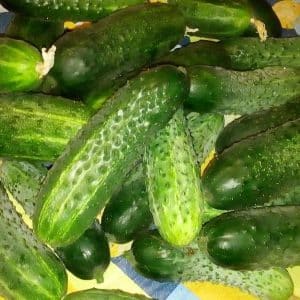
Unlike many other cucumber crops, Red Mullet has the ability to self-pollinate and is able to set fruit without the help of insects, which makes growing the hybrid in a greenhouse much easier.
Cucumbers are resistant to temperature fluctuations. They are suitable for cultivation in all regions of our country.
Red mullet fruits are distinguished by a rich cucumber aroma and a sweet taste without bitterness. They do not outgrow even if collected untimely.
The hybrid is immune to many diseases characteristic of cucumbers.
Advice! Chemical agents for disease prevention significantly reduce the environmental friendliness of crops. Many gardeners are abandoning store-bought preparations in favor of less effective but safer homemade formulations.
Beneficial features
Cucumbers contain a large amount of liquid (95%). Per 100 g of product there are from 14 to 16 kcal, 2.4 g of carbohydrates, 0.8 g of protein and only 0.1 g of fat. These fruits are recommended for consumption by people trying to lose weight.
Despite their low energy value, greens contain a large amount of useful substances: vitamins A, B, C and K, minerals (sodium, magnesium, calcium, copper, potassium), iodine, fiber, chlorophyll.
Thanks to this composition, eating cucumbers has a positive effect on the condition of the gastrointestinal tract, cardiovascular system, urinary system, and immune system. Red mullet also helps strengthen teeth, improve the condition of skin and hair, and overall rejuvenation of the body.
Attention! Cucumbers rarely cause allergies.
Main characteristics
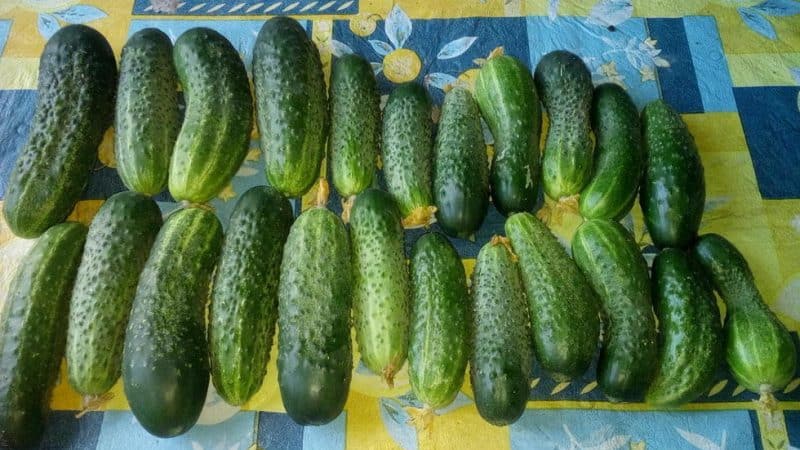
Description of Red Mullet will please even the most demanding gardeners. Despite its unpretentiousness, this hybrid has high yields. Despite their hybridity, such cucumbers are often grown for sale.
Characteristics of the Red Mullet:
| Options | Indicators |
| Bush type | Indeterminate. Long-climbing. The bush branches heavily. The leaves are medium sized, bright green. All inflorescences on the plants are female. Forms ovaries according to the bouquet type. From 8 to 12 fruits are formed in one leaf axil. The largest number of ovaries are formed on the central stem. The stalks are short. |
| Fruit | Medium size. The length of one greens is 8-10 cm. The weight of each of them does not exceed 100 g. The fruits are not prone to overgrowth even if harvested at the wrong time. All fruits on the bush are approximately the same size. The shape is leveled cylindrical. The skin color is dark green, lighter at the top. Thin light lines extend from the top 2/3 of the fruit. The fruits are large-lumpy, with white spines. The skin is thin. The flesh is dense, crispy and juicy. The taste is sweet, with a rich cucumber aroma, without bitterness. The seeds are small and soft, not suitable for sowing. |
| Productivity | High. From 1 bush you get up to 7 kg of fruit. From 1 sq. m harvest up to 15 kg of crop. |
| Ripening time | Early. Cucumbers are ready for harvest already 45-50 days after sowing the seeds. Differs in friendly maturation. |
| Growing method | It is cultivated both in greenhouses and in open ground in all regions of our country. |
| Transportability | High. Suitable for long distance transportation, they remain strong and fresh for up to 3 weeks. |
| Disease resistance | It is resistant to major cucumber diseases. |
Advice! It is not difficult to distinguish male inflorescences from female ones in cucumbers. There is a miniature cucumber at the base of the female flowers. Since the Red Mullet hybrid is parthenocarpic, female flowers predominate on the bushes.
Hybrid agricultural technology
Cucumbers are grown both in greenhouses and in open ground. In both cases the yield is equally high.
To get a good harvest of cucumbers, it is recommended to start preparing the beds in the fall. First of all, you need to choose the right place to sow the seeds.
Cucumbers are planted in semi-shaded areas of the garden. To artificially create shade, tall crops are planted on both sides of the beds.
Advice! It is not recommended to plant melons and melons next to cucumber beds, which attract dangerous insects and infectious agents. In the immediate vicinity of Barabulka, only those cucumber varieties that are immune to the same diseases are planted.
In the fall, the beds are dug up and cleared of plant debris. Weeds and cultivated tops are crushed and buried in the ground. In the spring you will get fertile soil.
Another way to make the soil more fertile is to bury chopped peels (fresh and rotted) of bananas in it in the fall. Throughout the year, the peelings of this fruit are placed in a barrel standing on the street.
In spring, for every 1 sq. m add 25 g of superphosphate and ammonium nitrate. The soil is watered with a hot solution of copper sulfate.
Cucumbers love soil with low acidity levels. To test the acidity of the soil, use litmus paper. Another way: collect some earth in a bucket and sprinkle it with soda. After this, the mixture is poured with a small amount of water and the result is observed. If bubbles appear, it means the acidity is increased.
To reduce the acidity of the soil, add dry lime or ash. Sand is added to loosen the soil.
Landing
Cucumbers are grown by seed and seedlings. In the second case, the harvest will appear earlier. The seedless method is suitable only for the southern regions.
If the seeds are coated with nutrients, then they are sown in the ground without prior preparation. The manufacturer marks the processed seeds with a bright color. Information about pan coating or glazing of seeds is indicated on the packaging.
The hybrid material is often processed and calibrated in production, so preparation is not necessary. If the planting material was not processed in the factory, this is done at home. This process includes the following steps:
- The seeds are carefully examined. All specimens must be dense, with the same color.
- A month before planting, calibrated planting material is placed in a warm place. Warmed seeds germinate faster.
- To speed up the germination of planting material, it is soaked in a growth stimulator for a day. Both store-bought medications (Epin) and a homemade solution prepared from a full teaspoon of honey and a glass of water are suitable.
- Most gardeners prefer to germinate planting material before sowing. It is wrapped in a damp cloth (it should remain damp throughout germination) and put in a warm place for 3 days.
- To harden the seeds, they are placed in the refrigerator for 48 hours.
Seed method
The seed method of growing Red Mullet is possible only in areas with a warm climate. The time for sowing seeds depends on the region:
- southern regions – end of April;
- cities with a temperate climate - end of May;
- northern part of the country – first half of June.
The holes are dug in rows, in a checkerboard pattern. Use a 50x50 scheme.
2 days before sowing the seeds, a 5 cm layer of rotted manure and the same amount of soil are placed on the bottom of the hole. The ingredients are mixed. The rest of the space is filled with garden soil. The prepared wells are poured with boiling water.
Before sowing the seeds, the holes are watered with settled water at room temperature. Since the germination rate of Red Mullet seeds is close to 100%, 1 seed is sown in each hole to a depth of 4 cm.
The crops are covered with film. It is opened slightly for ventilation every day. Crops are watered as the soil dries out. The film is completely removed after 2-3 weeks. If there is a threat of night frosts, the plants continue to be covered overnight.
Seedling method
The seedling method of growing cucumbers is considered the most reliable. It allows you to get an early harvest and is suitable for all regions. In this case, the time for sowing seeds also depends on climatic conditions: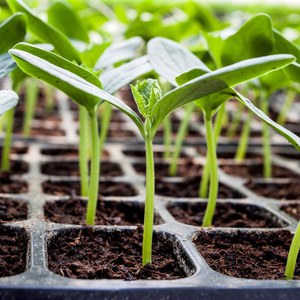
- southern regions – early April;
- cities with a temperate climate - end of April;
- northern part of the country – first half of May.
It is recommended to grow cucumbers immediately in individual pots. Both purchased plastic and peat containers and homemade pots are suitable.
The most unusual containers for growing seedlings:
- Peels of oranges and grapefruits. The pulp is removed from the fruit, leaving the peel intact. Make a large hole on top (like a pot), and a small drainage hole on the bottom. There is no need to remove such pots when placing them in a permanent place; they will unfold, providing the plants with nutrients.
- Eggshell. To do this, make a hole in the top and bottom of the eggs and blow out all the contents.A piece is broken off at the top of the shell to create a large enough hole. The shells are filled with soil and placed in trays (for eggs). When transplanting seedlings to a permanent place, the eggshells are split into large pieces. They will be needed for pest control.
Soil for seedlings is bought in the store (universal soil mixture) or prepared independently. To do this, mix 1 part of humus and garden soil with 0.5 parts of sand or sawdust. Add 1 tbsp to a bucket of composition. l. ash and 1 tbsp. l. nitrophoska.
Containers for seedlings and soil are disinfected. To do this, use boiling water or a dark pink solution of potassium permanganate.
The containers are filled with soil, which is watered with warm water. 1 seed is sown in each of them to a depth of 2 cm. The crops are covered with film and placed in a place with a temperature of 24-26 °C.
After seed germination, the film is removed. Plants are moved to a comfortable room temperature in a bright place. If necessary, use fluorescent lamps.
Water the seedlings 2 times a week with warm water. Additionally, the leaves are sprayed with a spray bottle.
Advice! To minimize the risk of infection of young plants, sprinkle the soil near them with a small amount of cinnamon powder.
After 2 true leaves appear, the plants are watered with fertilizer prepared from 1 tsp. water and 1 tsp. nitrophoska.
A week before planting in a permanent place, the seedlings begin to be taken outside. Hardening allows cucumbers to quickly adapt to new conditions after picking.
3 weeks after sowing the seeds, the seedlings are planted in a permanent place. Use a 50x50 planting pattern. The root collar is not buried when planting.
Basic rules of care
Indeterminate red mullet cucumbers must be tied up.Rigid wire is installed at a height of 1.5-2 m. Synthetic cords are tied to it, through which cucumber loops are threaded.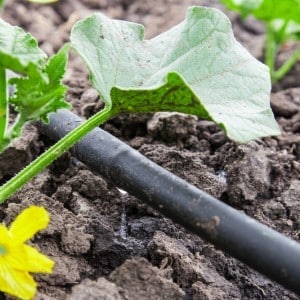
Bushes need to be formed into 1 stem. All side shoots are pinched, leaving only 15-20 cm. The higher the shoot, the longer it should be.
For convenience, the growth of the main stem is artificially limited. When it reaches the height of the main wire, it is wrapped around the support, lowered down and pinched after fruiting on the upper shoot.
Water the cucumbers generously, spending for every 1 square meter. m 7 liters of water. After this procedure, as well as precipitation, the soil is loosened. We weed the beds once a week during loosening.
Fertilize every 2 weeks. Alternate chicken manure diluted 10:10 with a solution prepared from 10 liters of water, 25 g of superphosphate, 25 g of urea and 20 g of potassium sulfate. 1 liter of fertilizer is used for each plant.
Gardening tips
Gardeners advise remembering a few rules. They will help you get a rich harvest and avoid many problems:
- Leaves at the bottom of the bush are recommended cut off. This promotes better air exchange.
- Before the inflorescences appear, cucumbers watered 2 times a week and spray them. After the flowers appear, water is poured under the root daily. You can't get pollen wet.
- The day before deposit feeding The beds are watered abundantly.
- Cucumbers are planted and watered early in the morning or at sunset. If this is done during solar activity, burns will appear on the leaves.
- When transplanting seedlings to a permanent location, some gardeners coat the roots of the plants with a thin layer of honey. This will help cucumbers quickly adapt to new conditions and act as additional protection against fungal infections.
- If several varieties of cucumbers grow nearby, it is recommended to place cobblestones with different patterns on their border. This will decorate the garden and prevent confusion.
- As an additional feed for seedlings and adult plants, you can use the water in which vegetables and eggs were boiled.
Diseases and pests
Red mullet cucumbers have high immunity to the main diseases of melons and melons. Gardeners still recommend adhering to the rules of prevention, which include observing crop rotation, watering and rooting rules, as well as weekly inspection of plantings.
Effective but safe methods will help protect you from pests and some infections:
- To prevent the occurrence powdery mildew, cucumbers are sprayed with milk or whey diluted 1:1 with water once every 2 weeks.
- In order to get rid of ants, piles of baking soda and powdered sugar mixed in equal proportions are poured between the rows.
- If the beds are attacked rabbits or squirrels, along the cucumber rows they make a fence of plastic forks stuck with the teeth up.
- From slugs and snails Large pieces of eggshells scattered between plants will be saved.
- Another way to protect yourself from ants and snails – coffee grounds scattered on cucumber beds. This product will also serve as an additional plant food.
- From aphids and arachnoid tick Plants are protected by spraying the bushes with a soap solution or a decoction of bitter herbs.
Harvesting and application
The first harvest of red mullet is obtained in May or June. Plants bear fruit until the first frost.
Cucumbers are stored in a cool, damp place. If you plan to store the crop for a long time, then the greens are regularly sorted, removing withered and rotten fruits.
Red mullet cucumbers are universal in use. They are suitable for canning, pickling and fresh consumption.
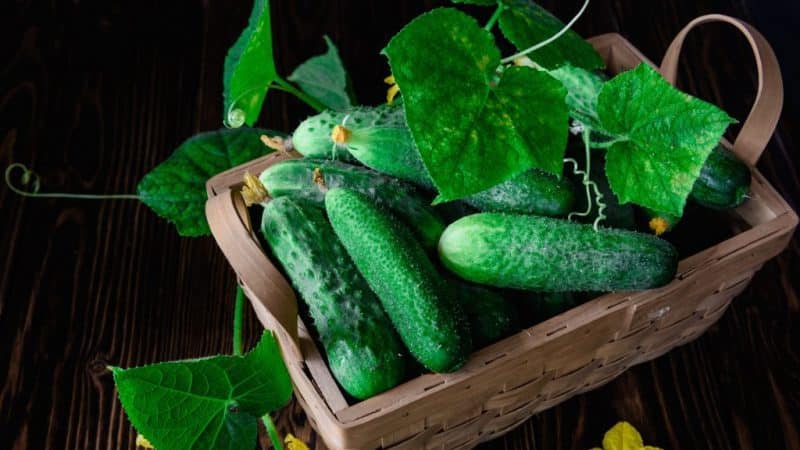
Advantages and disadvantages of a hybrid
Benefits of Red Mullet:
- immunity to disease;
- high productivity;
- excellent taste without bitterness, juicy pulp, soft small seeds;
- immunity to temperature fluctuations;
- ease of care;
- early ripeness;
- friendly return of the harvest;
- Possibility of growing in open and protected ground.
The disadvantage of Red Mullet is the inability to use the seeds of the hybrid crop for planting. This increases the cost of the fruit.
Reviews
Reviews from gardeners about Red Mullet cucumbers are mostly positive. Gardeners like smooth and beautiful fruits that turn out the same as in the photo.
Inga, Krasnodar: “We have been planting red mullet directly in open ground for 3 years. Really like. The cucumbers turn out tasty and crispy; if you pick them on the 3-4th day, you get gherkins for preservation. Easy to grow and require minimal care. Recently, we have ants at our dacha, to protect my cucumbers from them, I sprinkle the beds with red hot pepper mixed with soda.”
Andrey, Moscow: “Last year I planted Red Mullet in open ground on my mother’s recommendation. The fruits turned out really tasty and beautiful, just like in the photo. The yield was also encouraging. 2 sq. m of beds was enough for canning, food, and treating friends. The only thing is that I cannot say about the absolute resistance of the hybrid to rot. The summer turned out to be cold and rainy - several bushes became sick. This year I planted it in a greenhouse.”
Conclusion
Red mullet is suitable for cultivation both for personal use and for sale. From 1 sq. m produce more than 15 kg of fruit.At the same time, the hybrid requires a minimum of care and is resistant to diseases, cold snaps and other negative environmental factors.
The fruits of the hybrid are crispy, sweet and aromatic, without any bitterness at all. They do not outgrow and are considered universal in use.